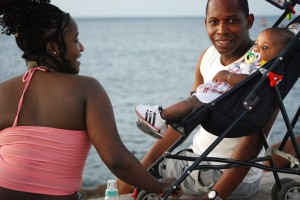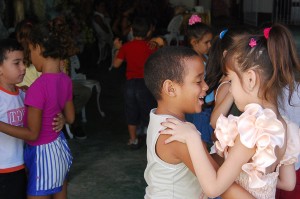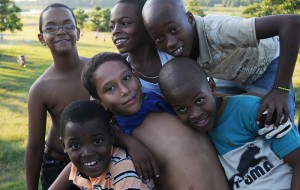The Safe Streets of Cuba

HAVANA TIMES — Elias Carranza, a senior UN official for the Prevention of Crime and the Treatment of Offenders Institute, said Cuba is the safest country in the region.
It is free of the critical situation of violence that characterizes the continent, with the island having made great achievements in reducing crime.
I immediately started looking for information about the most common crimes on the island and figures that could be compared to other countries in the region, but authorities refused to give me practically any information concerning this.
Nor does the issue appear in the national media. There’s no “crime page” and nothing is published about crime, robberies, rapes or murders. Nothing was even written when 33 patients starved to death in a Havana psychiatric hospital.
To counter the vacuum, citizens created “Radio Bemba” (Radio Lips), where information is transmitted from person to person. It’s true that the information is distorted a bit, but it travels with astonishing speed. Within hours, news of a crime that occurred in Holguin Province can reach Havana.
Living in Cuba, one “feels” fairly safe. No one is afraid of walking around at night, and I’ve wandered through the worst slums without ever being attacked. In 20 years, the most violent experience I suffered was someone pulling on my wife’s handbag in Old Havana.
And I’m not alone. An African American cameraman, who worked in Cuba and hung around in the most “difficult” neighborhoods of Havana, told us laughing that Cuban criminals are toddlers compared to the ones in the New York City neighborhood where he grew up.

Looking around us — in Haiti, Mexico, Central America, Colombia, Venezuela, Brazil, the United States — one wonders how Cubans have managed to maintain such minimal levels of social violence. The answer involves many factors, and none is easy to analyze.
Prior to 1959, the island wasn’t so peaceful. The gun-toting criminals became such a force that one president of the republic was forced to negotiate with them and appointed some of them police officers. Later, to complete the task, the US mafia appeared and took over the casinos.
The control of violent crime in Cuba can be thanked firstly to Washington, which required the island to create a highly efficient security service, one that for years was capable of infiltrating and maintaining a spy in the US Defense Intelligence Agency (DIA).
They learned to fend off violent planned attacks by their neighbor — invasions, assassination attempts, bombings, sabotage, uprisings, etc. — and then applied those same principles and the same techniques to get rid of common criminals.
They infiltrated the most violent criminal groups and captured their members one by one. Ultimately, some of those wrongdoers went to the wall, others ended up in jail and many left the country, taking advantage of the immigration facilities offered by the United States to all Cubans.
In the late 90’s, narco-trafficking had begun to grow on the island – moving a larger volume of drugs, achieving a certain stability in the supply, and having bought off some policemen. At the same time, more violent crimes began being committed, some of them appalling.
Therefore the intelligence services sprang into action supported with information from the Committees for the Defense of the Revolution (CDR) in a nationwide operation to put the major traffickers and their accomplices in jail.

There’s a CDR on every block of every city or town, each doing night-watch duty across the entire island. These played a key role in dismantling the violent opposition in the 1960s, though their surveillance activity is also an obstacle to criminal activity in general.
For decades the CDR branches were so powerful that they extended political guarantees to area residents. Today they have lost ground and have become a kind of tropical version of the cameras that monitor the streets of European cities – the ones that are always watching us but which we never see.
I confess that sometimes the CDR activists can be annoying. If a stranger stays over at my house for a few days, they’ll drop by to ask and jot down their personal data. If I were harboring a criminal, a CIA operative or some lover, it would all be just as complicated.
Notwithstanding all this, the most important component for containing the level of social violence could be the care given to children. Like former vice president Carlos Lage told the UN, 200 million children around the world sleep in the streets – but none of them is Cuban.
This explains why there are no adolescent hired guns, gang members, drug dealers or gangs of teenaged robbers in Cuba. It’s natural that these don’t exist since there’s not a single street child; all youth are under the protection of their families or state institutions.
The most effective incubator of violent offenders is the social violence suffered by millions of children around the world, those who are abandoned by their parents, sleeping in parks, eating garbage, sexually assaulted and sniffing glue.
There’s no need to go to the slums on the continent to understand why the writer Mario Benedetti noted that childhood “is often a lost paradise, and for others it’s a hell of shit.” It could be added that it’s in the fires of those hells where our worst demons are forged.
(*) An authorized Havana Times translation of the original published by BBC Mundo.






Why can we copy from Cuba here in USA ?
The conclusion of this story is so true. The children in Cuba are healthy, clean (so clean they sparkle), educated and confident. When staying in Casas, seldom are the doors locked — except for the rooms of the tourists who bring their fears from their own countries. When talking to the children of Cuba, and my Spanish is anything but perfect, they have no inhibitions – they try hard to understand my accent and poor grammar and they respond intelligently. When out at an event, I have seen young fellows seven or eight years old dancing with their grandmas — smiling with glee. We in Canada could certainly take a lesson from Cuba in regards to our children. In British Columbia we have far more child poverty than any other province in the country. How sad for us.
I am born in Cuba and left at aged 14 returning as an educated adult.. I have also walked all over the entire country and know every nook and cranny i am orig from Matanzas and have never had one thing stolen, nor have i or any of my friends or family members ever been injured via a punk kid or adult..??? What does this say And i am a female
Also, this has nothing to do with a police presence because trust me they are far and few between securing as they should the visitors as well as the citizens. Where there may be a purse snatching or food theft it never compares to anything in MIAMI. Suffice that, if and when the lies of the empire were to ever cease and the real talks begin maybe maybe there could be some business between the empire and mi isla! Ya right!..Also unless and until adiults step up the the plate and stop this 55 yrs embargo and the other petty issues>>>OH oWELL! its up to us …the proud ” Cubans pre/post 1959 to well the real truth
there is a way for dane harper to know if for example habana is safe. walk the streets of any suburb of habana at any time of the night or early morning. if you are street smart and have lived in dangerous countries you will get the vibes. no one will be tracking you to set up a robbery. the CDR will know you are there and will know that you are a foreigner. cubans know this because of small things like clothing unobtainable in cuba. unless you buy all your clothing in cuba you will stand out but you won`t know it. this system is not unique. japan has it. chinatown in manila has it. i don`t care if foreigners like fidel or not. i am stating facts. cuba is the safest place in the americas. there are few places in the world that are safer. britain has had a huge crime problem. influential people have had their phone hacked. the so called news is the same day after day. man killed in road accident, bank robbed etc. there is a humorous definition of news. dog bites man is not news. man bites dog is news. there are any number of serious and important news stories around the world every day. man bites and partially eats a homeless man in florida is really and truly important news. no news is good news. i like the international weather reports. i am fascinated by the weather in central asia. it is second only to my interest in the weather in iceland and the shetland islands.
You have it backwards. In times of prosperity and an abundance of goods and money, crime rates go up. In a depressed economy where nobody has any money and few possessions crime rates go down. If Cuba does not honestly to the best of its ability report the country`s crime statistics, there is no way to know whether or not Cuba is actually any more safe than either Heaven or Hell. I would say that a country which even witholds the number of people in its prisons can safely say that it is the safest place in the world; even if that is not true. Okay. Cuba is the safest and most prosperous country in the western hemisphere; that should make Fidelito smile.
I (Cuban born to US citizen mother) traveled to Cuba in 2004 and walked the streets of Havana at night with my cousins, saw ladies and small children never feeling the slightest danger. Now with the cruel USA Embargo which was meant to “… make the Cuban people scream”,one would expect more desperate people willing to commit crimes for their personal gain.
My cousins knew of one murder in Havana in the last few years!! lol
Very soon that antiCuba wall will come down and I wont feel so guilty about leaving with my parents when I was 10 years old.
I read, “there’s no ‘crime page’ and nothing is published about crime, robberies, rapes or murders” and could only think, Great!! Capitalist mainstream media is obsessed with reporting crime, robberies, rapes and murders to distraction. Even Canada’s nationally-funded broadcaster, presumably more immune to pressures of sensationalism, never misses an opportunity to report criminal activity. I listened to CBC International when I was in Cuba, wanting only to keep up on events at home. Most of the time headline news began with several crime stories.
Last week in Toronto, a man shot up a large downtown shopping mall while gunning for someone who had knifed him earlier, injuring a number of people in the process. This was a major story, dominating the local news. In the same week, 2,000 people marched downtown in a ‘cacerolazo’ protest in support of Quebec students who oppose raising student fees – most students here who receive a university education end up with a massive debt, enslaving them afterwards for years, like indentured servants, to pay it off. The cacerolazo protest was not covered by any newspaper in Toronto.
The skewed reporting of crime has an effect. Despite statistics showing falling crime rates, people in Toronto feel unsafe even though they are highly unlikely to be a victim of crime or to know anyone who is. They end up suspicious and fearful of their fellow citizens. One Toronto city councillor is advocating bring back capital punishment!
Just another snapshot story of what is taking place in capitalist Canada, hopefully a cautionary tale.